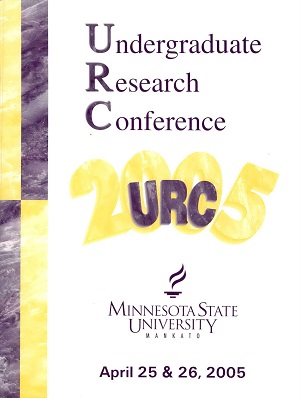Comparison of Macroinvertebrate Populations at Three Locations After Several Major Storm Events
Location
CSU 285
Start Date
25-4-2005 10:30 AM
End Date
25-4-2005 12:00 PM
Student's Major
Biological Sciences
Student's College
Science, Engineering and Technology
Mentor's Name
Beth Proctor
Mentor's Department
Biological Sciences
Mentor's College
Science, Engineering and Technology
Description
Benthic macroinvertebrates (spineless organisms that live in water and are visible with the naked eye) have been used for decades as indicators of water quality. The purpose of our research was to determine if the number and species composition of benthic macroinvertebrates were different between 3 sites: Blue Earth River upstream of the Rapidan Dam and reservoir; Blue Earth River downstream of the Rapidan Dam and at the LeSueur River just prior to it confluence with the Blue Earth River. Artificial substrates (Hester-Dendy) were placed at each sampling site. The substrates were to be collected after 4-5 weeks of colonization between May and September 2004. Due to the unusually wet weather and high flows, all artificial substrates were lost. In October macroinvertebrates were sampled using the pick method at two of the original sites (Blue Earth River below the Rapidan Dam (Jones Ford) and LeSueur River) and at the Beauford Creek. We will discuss the differences between the macroinverterates found at these sites plus problems associated with field sampling.
Comparison of Macroinvertebrate Populations at Three Locations After Several Major Storm Events
CSU 285
Benthic macroinvertebrates (spineless organisms that live in water and are visible with the naked eye) have been used for decades as indicators of water quality. The purpose of our research was to determine if the number and species composition of benthic macroinvertebrates were different between 3 sites: Blue Earth River upstream of the Rapidan Dam and reservoir; Blue Earth River downstream of the Rapidan Dam and at the LeSueur River just prior to it confluence with the Blue Earth River. Artificial substrates (Hester-Dendy) were placed at each sampling site. The substrates were to be collected after 4-5 weeks of colonization between May and September 2004. Due to the unusually wet weather and high flows, all artificial substrates were lost. In October macroinvertebrates were sampled using the pick method at two of the original sites (Blue Earth River below the Rapidan Dam (Jones Ford) and LeSueur River) and at the Beauford Creek. We will discuss the differences between the macroinverterates found at these sites plus problems associated with field sampling.
Recommended Citation
Imes, Michelle; Cindy Sparrow; and Robin Erickson. "Comparison of Macroinvertebrate Populations at Three Locations After Several Major Storm Events." Undergraduate Research Symposium, Mankato, MN, April 25, 2005.
https://cornerstone.lib.mnsu.edu/urs/2005/oral-session-D/6




